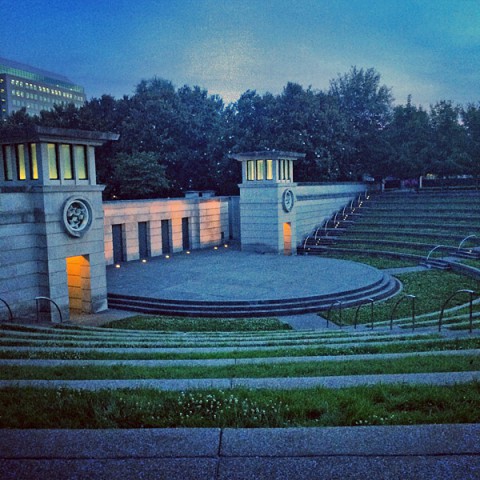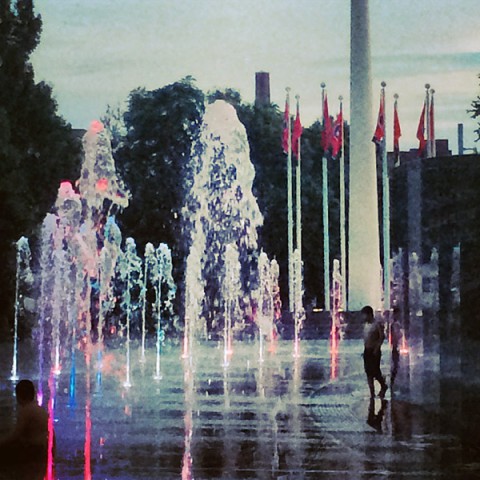 Nashville, TN – I’ve always been interested in what lies beneath the ground I tread on each day. In adolescence, my girlfriends and I wore so many grooves into the cracked sidewalks—often dipping into alleys to watch the boys play hockey—that as an adult, I began to wonder what kind of geology lay just beneath my urban, yet Appalachian home of Johnstown, Pennsylvania.
Nashville, TN – I’ve always been interested in what lies beneath the ground I tread on each day. In adolescence, my girlfriends and I wore so many grooves into the cracked sidewalks—often dipping into alleys to watch the boys play hockey—that as an adult, I began to wonder what kind of geology lay just beneath my urban, yet Appalachian home of Johnstown, Pennsylvania.
I explored this, and how that landscape may have shaped me in my poetry collection, The Pattern Maker’s Daughter.

The Pattern Maker’s Daughter
I am rooted in this Appalachian bedrock,
a sliver of the earth’s volcanic events.
Ancient as Africa, shiny as new slag scraped
from our hillsides, high as the Rockies
that walled us in, (our lilting speech, our bent
shoulders and inhibitions)
as it stretched in infancy
from Mexico to Newfoundland.
From “Part of This Earth,” The Pattern Maker’s Daughter, Bottom Dog Press, 2012
Today, I wear grooves into a very different pavement in downtown Nashville: city blocks, and the adjacent areas of the riverfront and the local parks. I hadn’t given too much thought to the geology of my new Southern home. How could it be as fascinating as my hometown, with its random streambed patterns and famous floods, not to mention geographical features like the Conemaugh Gap?
Well after a year and a half of treading new soil, Tennessee’s earthen secrets have answered back to me loud and clear. It seems my newly adopted city has some rare and colorful origins that are pretty special to archeologists and historians—and especially meaningful to one poet with a penchant for amateur geology.

The intrigue started when I began to be continually drawn to one particular public space; Bicentennial Park. It easily became my favorite destination for walking, running, and observing nature. Located “in the shadow of the state capitol,” and next to the Nashville Farmers Market, this urban state park has always felt worlds away from the city, and has called to me softly with a serene vibe I couldn’t quite put my finger on.
Bicentennial is a spacious and graciously laid-out space, with low hanging trees that turn a brilliant flowering white in the spring, and a beautiful grass mall where people can lay on blankets, kick a ball, or throw a Frisbee. For city dwellers, it operates as a virtual backyard and a fresh-air breathing space, with cool history to boot; the west side of the park boasts the “Pathway of History,” a virtual outdoor museum with historic events of the state engraved into marble stones that run the entire length of the park. Here you can read about Tennessee’s past two centuries, as well as information on its ancient beginnings.
Perusing the marble installation one day, I paused to take in some neat geo-nuggets (if you have the chance, read more about the “Nashville Dome” and how the city was formed by a rare and powerful earth force…) and it inspired me to read more about the origins of my new state—stirring a muse for poetry that I hadn’t felt in quite a long time.
Directly adjacent to this award-winning public space, (the state park was named one of the Top 10 Public Spaces by the American Planning Association) is the site of the historic Sulphur Dell baseball stadium. Historians had already known that underneath the outfield of the ball field was a Native American burial ground. (It was moved prior to construction, but not before the graves were looted many times over, according to research.)
But recently, as construction for the new Nashville Sounds stadium began there, archaeologists found even older evidence (1150 A.D.) of prehistoric use of the basin: tools for producing salt in a large scale “factory” if you will. In fact, evidence abounds that a “huge, huge metropolis,” or prehistoric city existed underneath the new ballpark, and thusly under my beloved park.
The tension between the “Play Ball!” fast-track proponents of the stadium and key heritage organizations is another story entirely, which I will investigate further soon. But did I have my answer, perhaps, to why this park’s feel and tranquility were so palpable to me? Could it be the meditative nature of the Native Americans and their deep spirit-roots in the Tennessee soil?
For me, no matter what kind of day I’ve had, when I arrive at Bicentennial, I feel an almost immediate feeling of reflective peace. (And that’s without smoking a peace pipe.) I’ve had some of my most productive runs here and also some of the (dare I say “Zen-like?”) walks, and always find something inspiring to photograph. Whether its children running through the lighted and colored fountain display where the lines to a favorite Langston Hughes poem are engraved in the marble backdrop: “My soul has grown deep like the rivers…” or boys climbing trees only to fall and repeatedly climb them again, I never leave without my soul being nourished in some felt way.
There are other area parks that boast more showy attributes, like Centennial Park, with its grand replica of the Parthenon, and its regular music concerts and active festival calendar. If you’re a musician, you’ll want to take your guitar and meet up and jam with others at Centennial, where (though I enjoy it enough) I still feel the vibrations of the adjacent West End city streets.
In Bicentennial, the city is quieted; it’s a place where a solitary musician might seat themselves in the direct center of the “Court of 3 Stars and Bell Carillon” ringing chimes located at the end of the mall—where he or she can hear their voice in stereo sound if projected just right. (A trick all the Segway tour guides point out…)
My new favorite space is a place you can kick around a ball, or lie on a blanket and do nothing at all. It’s a place to come to nurse your daily small heartaches, to compose a song or poem in your head, or to celebrate the little victories with a jovial run or plastic cup of bubbly you pack in your picnic basket for you and someone special.
Centennial is a place you go to commune and talk to other people; Bicentennial is a park where you go to talk to yourself. When the voices of the earth start speaking back, I’ll let you know.
Photo Gallery








